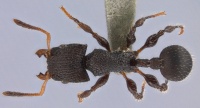Dilobocondyla silviae
| Dilobocondyla silviae | |
|---|---|

| |
| Scientific classification | |
| Kingdom: | Animalia |
| Phylum: | Arthropoda |
| Class: | Insecta |
| Order: | Hymenoptera |
| Family: | Formicidae |
| Subfamily: | Myrmicinae |
| Tribe: | Crematogastrini |
| Genus: | Dilobocondyla |
| Species: | D. silviae |
| Binomial name | |
| Dilobocondyla silviae Zettel & Bruckner, 2013 | |
Nothing is known about the biology of Dilobocondyla silviae.
Identification
Zettel and Bruckner (2013) - Worker: Blackish brown; scape and distal tarsomeres yellow. Posterior margin of head concave. Frontal carinae strong, reaching posterior corners of head. Sculpture of head and mesosoma moderately coarse; interspaces mostly reticulated and matt. Petiole slender, PtI 191 - 195.
This species is very similar to Dilobocondyla chapmani sensu lato in most characteristics, but immediately distinguishable by blackish colour, small size, a very distinct micro-reticulum on the dorsum of the mesosoma, and by slightly smaller PtI (191 - 195 vs. 202 - 210). It can be distinguished from small specimens of the D. chapmani complex (see notes above) by a very different form of the propodeum, which is not compressed.
Keys including this Species
Distribution
Latitudinal Distribution Pattern
Latitudinal Range: 10.86666667° to 10.86666667°.
| North Temperate |
North Subtropical |
Tropical | South Subtropical |
South Temperate |
- Source: AntMaps
Distribution based on Regional Taxon Lists
Indo-Australian Region: Philippines (type locality).
Distribution based on AntMaps
Distribution based on AntWeb specimens
Check data from AntWeb
Countries Occupied
| Number of countries occupied by this species based on AntWiki Regional Taxon Lists. In general, fewer countries occupied indicates a narrower range, while more countries indicates a more widespread species. |

|
Estimated Abundance
| Relative abundance based on number of AntMaps records per species (this species within the purple bar). Fewer records (to the left) indicates a less abundant/encountered species while more records (to the right) indicates more abundant/encountered species. |

|
Biology
Castes
Known only from the worker caste.
Nomenclature
The following information is derived from Barry Bolton's Online Catalogue of the Ants of the World.
- silviae. Dilobocondyla silviae Zettel & Bruckner, 2013: 138, figs. 2, 8, 14 (w.) PHILIPPINES (Leyte I.).
- Type-material: holotype worker, 1 paratype worker.
- Type-locality: holotype Philippines: Leyte I., Leyte Prov., Baybay, LSU, 50-100 m., Calbiga-a River, 20-21.iii.2005, no. 422 (Zettel & Pangantihon); paratype with same data.
- Type-depositories: NMPM (holotype); HSZC (paratype).
- Status as species: Chen, et al. 2019: 138 (in key).
- Distribution: Philippines (Leyte).
Unless otherwise noted the text for the remainder of this section is reported from the publication that includes the original description.
Description
Worker
Holotype: TL 3.91; HW 1.01; HL 1.07; CI 94; SL 0.61; SI 60; PnW 0.68; PtL 0.41; PtH 0.20; PtW 0.21; PtI 195; PpL 0.31; PpH 0.30; PpW 0.31. Paratype: TL 4.06; HW 1.08; HL 1.17; CI 92; SL 0.68; SI 63; PnW 0.76; PtL 0.42; PtH 0.21; PtW 0.22; PtI 191; PpL 0.34; PpH 0.31; PpW 0.33.
Colour: Body uniformly blackish brown. Mandibles medium brown. Antennae chiefly brown; scape and base of funiculus yellow. Legs brown; trochanters, bases of femora, and distal tarsomeres pale.
Structures: Head dorsally with almost regular striation and very few interconnections posteriorly, interspaces filled with dense micro-reticulum; sides of head with reticulated rugae. Posterior margin of head concave; hind corners angular. Frontal carinae and antennal scrobes reaching hind corners. Clypeus with numerous longitudinal rugae; interspaces with reduced micro-reticulum, shiny.
Mesosoma entirely reticulated; rugae forming moderately large meshes; an imaginary line between pronotal corners transecting 12 meshes; interspaces shiny laterally, but micro-reticulated dorsally. Petiole and postpetiole with micro-reticulum that is strongly reduced on petiole posterodorsally and laterally. Petiole posterodorsally and laterally with coarse irregular rugae, slender; its dorsal outline in lateral view almost evenly convex, but slightly concave before hind margin; anteroventral tooth spine-like, slender. Postpetiole in lateral aspect with broadly rounded apex; both anterodorsal and posterodorsal surface with longitudinal rugae. Gaster tergite 1 at base with very dense fine striation distinctly longer than longest seta on postpetiole.
Type Material
- Holotype, worker, Leyte Island, Leyte Province, Baybay, above Leyte State University, Calbiga-a River valley, ca. 50 m a.s.l., Philippines, 10°52′0″N 124°43′0″E / 10.866667°N 124.716667°E, 20-21 March 2005, Zettel & C. Pangantihon, National Museum Manila.
- Paratype, 1 worker, Leyte Island, Leyte Province, Baybay, above Leyte State University, Calbiga-a River valley, ca. 50 m a.s.l., Philippines, 10°52′0″N 124°43′0″E / 10.866667°N 124.716667°E, 20-21 March 2005, Zettel & C. Pangantihon, H. Zettel Collection.
Etymology
This species is dedicated to the second author’s wife.
References
References based on Global Ant Biodiversity Informatics
- Zettel H., and H. Bruckner. 2013. Four new species of Dilobocondyla (Hymenoptera: Formicidae) from the Philippines. Zeitschrift der Arbeitsgemeinschaft Österreichischer Entomologen 65: 135-150.

